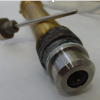Measurement device for Hydrogen concentration determination in gases and liquids
Technology description
| The name of the technology: | Measurement device for Hydrogen concentration determination in gases and liquids |
|---|---|
| Challenge: |
Measuring hydrogen concentration in the primary coolant of nuclear reactors is essential for ensuring both reactor safety and the efficiency of nuclear power plants. Additionally, this measurement is necessary to comply with stricter industrial standards designed to reduce corrosion risks. Accurate hydrogen concentration assessments in the cooling circuit are increasingly critical to ensure optimal reactor performance. Existing sensors face significant limitations, particularly regarding selectivity and response time, as they can measure hydrogen concentrations in the parts per billion (ppb) range but often lack the necessary specificity and promptness required for effective monitoring. The hydrogen sensor, highly selective to H2, is currently available from only one company in the global market, highlighting the global market need in this area. |
| Description: |
The H-meter, our dissolved hydrogen measurement device, features a membrane-covered amperometric sensor that provides a linear response. This device integrates the sensor with a control unit that records hydrogen concentration time profiles, as well as the temperature and pressure of the measured environment. We have developed a functional prototype of our device featuring enhanced electrode surfaces. Our H-meter was tested in a real environment at a nuclear power plant, demonstrating its quick response and long-term stability as a hydrogen sensor, with no comparable devices currently available on the market. However, further development is still required to address temperature compensation aspects. ADVANTAGES over current practice Pros 1. More hydrogen selective sensor compared to commercial devices used in powerplants. 2. Faster response time enabling the usage in the early warning system. 3. Linear response to hydrogen concentration is based on a physical principle of the sensor, so any inaccuracies due to the signal correction cannot occur. 4. Signal is not distorted by other species' presence. Cons 1. The membrane on sensor tip can be relatively easily damaged by mechanical attack. 2. More accurate temperature compensation is still needed. ADVANTAGES over competitors Pros 1. Cost-Effective: by about 20% lower price. 2. More hydrogen selective sensor compared to commercial devices used in powerplants. 3. Faster response enabling the usage in the early warning system. 4. Linear response to hydrogen concentration is based on a physical principle of the sensor, so any inaccuracies due to the signal correction cannot occure. Cons 1. The membrane on sensor tip can be relatively easily damaged by mechanical attack. |
| Commercial opportunity: |
The application prospects of this invention are promising, with potential uses in various fields such as nuclear engineering, chemical analysis, or environmental monitoring. In the field of nuclear engineering, the area of primal focus, this invention could be used to improve the safety and efficiency of nuclear power plant reactors. The ability to measure hydrogen concentration in both gases and liquids, with high selectivity and fast response time, could make this sensor a valuable tool with the potential to make significant contributions to various fields and industries. |
| IP protection status: | Know-how protected as Trade secret |
| Development status: |
Phase 3Corresponds with TRL 5 and TRL 6 Technology validation and implementing it in real environment. Testing the technology outside of the laboratory and its adjustment to external conditions.
|
| Partnering strategy: | Collaboration investment licensing spin-off |
| More information: | |
| Images: | |
| Categories: | Diagnostics Chemistry Theoretical and Applied Physics & Chemistry Electrical Engineering Chemical and bioengineering Engineering |
| Institution: | University of Chemistry and Technology Prague |
| Owner of a technology: | VŠCHT Praha |
